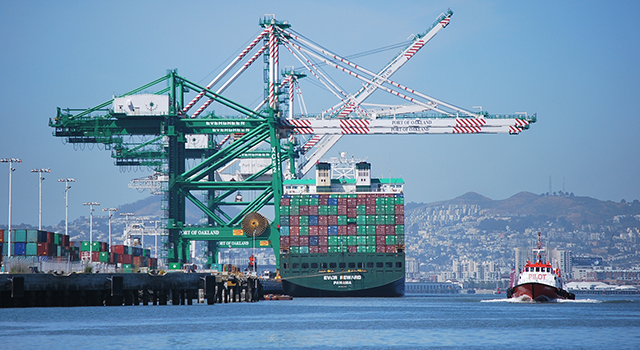On the eve of the 2016 Super Bowl, the Oakland Raiders seem likely to remain here through next season.

Photo by Joel Williams
By Patrick Burnson
Published: February, 2016
On the eve of the 2016 Super Bowl, the Oakland Raiders seem likely to remain here through next season. The Port of Oakland, however, had one of its key team members leave for greener pastures.
Ports America, the largest stevedore and terminal operating company in the United States, is realigning its West Coast strategy by investing in Los Angeles, Long Beach, the Pacific Northwest and western Canada. According to spokespeople, these regions have been identified as most suited to its growth goals.
At the same time, Ports America will soon be vacating the Outer Harbor Terminal at the Port of Oakland, leaving officials there in a scramble to find a new tenant. The port said vessels will be rerouted to adjacent terminals after the shutdown occurs. Port representatives assured shipping lines and cargo owners that planning is already underway to blunt the shutdown’s impact.
“We’re disappointed that Ports America is leaving,” said Port of Oakland Maritime Director John Driscoll. “But we’re in advanced discussions with our maritime partners here to prevent disruption to the Oakland business.”
Ports America Outer Harbor said it will continue with business as usual for 30 days, then cease vessel and cargo-handling operations. The company said it will close down the terminal in 60 days.
The Port of Oakland said it expects Ports America to meet all of its lease obligations until the two sides agree on an orderly transition of the property. The port added that it has engaged in prolonged discussions with Ports America about the operator’s future in Oakland. It said the decision to terminate the lease was made unilaterally by Ports America.
The Port of Oakland put a bright face on this last month, noting that the development could actually have some positive consequences. According to port officials, the departure of Ports America provides two significant opportunities: First, ships and cargo can be redirected to Oakland’s other marine terminals that have excess capacity. Second, the port can find new, better uses for Ports America Outer Harbor Terminal.
Options for the land could include uses unrelated to containerized cargo operations, the port said. That would be new for Oakland, which has been home exclusively to container ships since the 1960s.
Outer Harbor Terminal is one of five marine terminals leased to private operators by the port. More than 2,000 ships, most from Asia, berth at the terminals each year. The terminals load and unload containerized cargo transported by the vessels. More than two million containers move annually through the Port of Oakland.
Shippers Anticipate Chinese New Year
Bay Area shippers are now getting prepared for Year of the Monkey. The advent of Lunar New Year is the most important of the traditional Chinese holidays, but can also be disruptive to U.S. supply chains due to our extraordinary level of reliance on Chinese trade.
The Year of the Monkey will be ushered in on Super Bowl Sunday, February 7, and the celebration in Asia lasts one week. However, due to the nature of planning and scheduling in the shipping industry, the effects of the Chinese holiday last much more than just one week.
Shippers sourcing from China and elsewhere in Asia should be aware that government, construction and factories throughout China will be virtually shut down during the holiday, while ports and customs usually operate with a skeleton staff focusing on perishable priority items.
“Many manufacturers treat the holiday as an annual break and close down for two weeks or longer,” said Diana Maure of Lilly and Associates, an international logistics firm. She added that while commerce virtually comes to a standstill in China during the holiday celebration, companies manufacturing in China must rush their goods out in advance of the holiday, usually at higher quantities.
“That rush, both before and after the Chinese New Year, puts an increased stress on the supply chain, causing congestion and capacity issues for shippers,” Maure said.
“Along with the rush, it has become the norm for ocean carriers to omit one to two sailings a week during the most popular deadline date for production,” she continued. “These omissions, creating more demand, create further delays at the port and for shippers who need to secure space on these carriers.”
Patrick Burnson is the past president and current board member of the Pacific Transportation Association, based in San Francisco. www.pacifictrans.org

